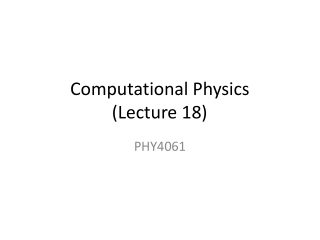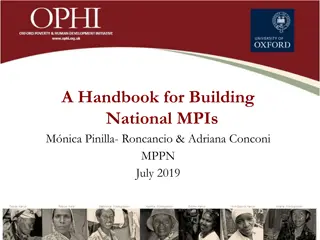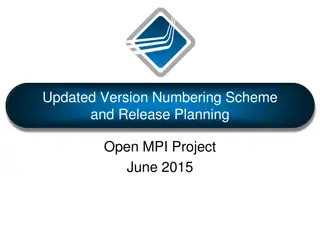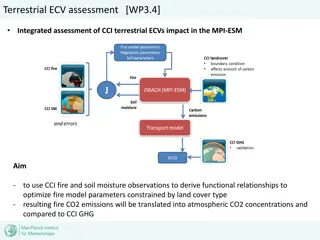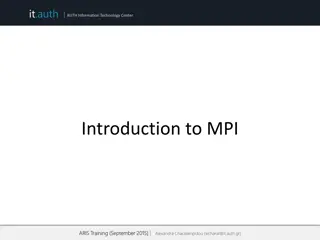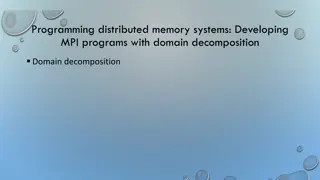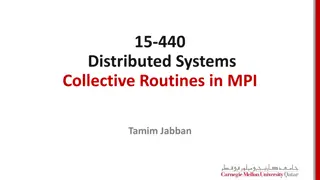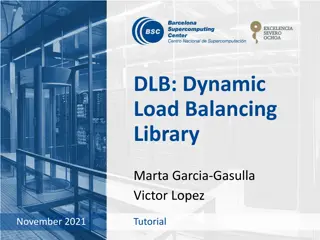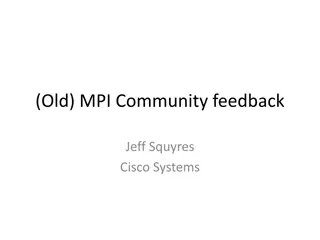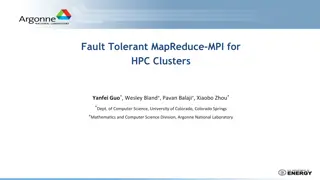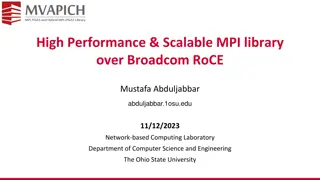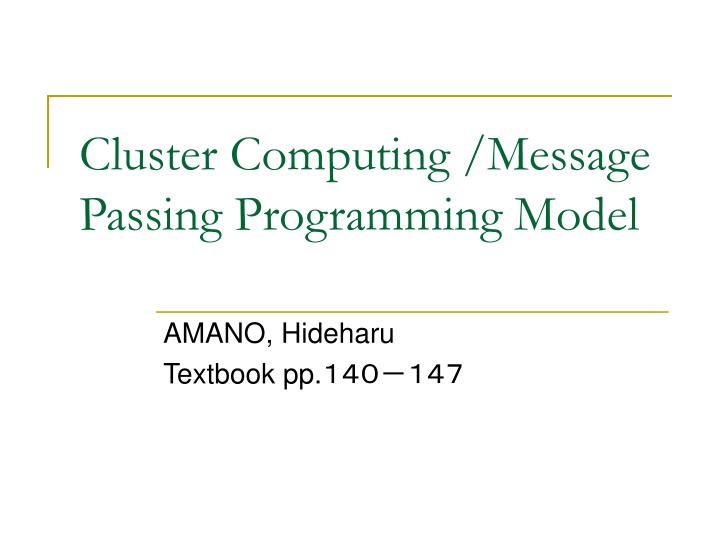
Cluster Computing and Message Passing Programming Model
Explore the world of cluster computing and message passing programming models, covering topics such as PC clusters, SAN, Infiniband, remote DMA, RHiNET cluster nodes, WSC, and message passing models with a focus on MPI.
Download Presentation

Please find below an Image/Link to download the presentation.
The content on the website is provided AS IS for your information and personal use only. It may not be sold, licensed, or shared on other websites without obtaining consent from the author. If you encounter any issues during the download, it is possible that the publisher has removed the file from their server.
You are allowed to download the files provided on this website for personal or commercial use, subject to the condition that they are used lawfully. All files are the property of their respective owners.
The content on the website is provided AS IS for your information and personal use only. It may not be sold, licensed, or shared on other websites without obtaining consent from the author.
E N D
Presentation Transcript
Cluster Computing /Message Passing Programming Model AMANO, Hideharu Textbook pp.
PC Clusters PC Clusters A Cost efficient highly parallel systems Recently used in datacenters Beowulf Clusters A root of PC clusters Standard CPU boards, Standard components LAN+TCP/IP Free-software A cluster with Standard System Area Network(SAN) like Infiniband is also common. Warehouse Scale Computers (Computing) A dedicated computer architecture for a large scale data center.
SAN (System Area Network) for PC clusters Virtual Cut-through routing High throughput/Low latency Out of the cabinet but in the floor Also used for connecting disk subsystems Sometimes called System Area Network Infiniband Myrinet Quadrics GB Ethernet: 10GB/40GB/100GB Ethernet Store & Forward Tree based topologies
Infiniband Point-to-point direct serial interconnection. Using 8b/10b code. Various types of topologies can be supported. Multicasting/atomic transactions are supported. The maximum throughput SDR 2Gbit/s 8Gbit/s 24Gbit/s 48Gbit/s DDR 4Gbit/s 16Gbit/s QDR 8Gbit/s 32Gbit/s 96Gbit/s HDR 50Gbit/s 200Gbit/s 400Gbit/s 1X 4X 12X
Remote DMA (user level) Local Node Remote Node System Call Sender Data Source Data Sink User Kernel Kernel Agent User Level RDMA Buffer Buffer Host I/F Protocol Engine Protocol Engine Network Interface Network Interface
RHiNET Cluster Node CPU: Pentium III 933MHz Memory: 1Gbyte PCI bus: 64bit/66MHz OS: Linux kernel 2.4.18 SCore: version 5.0.1 RHiNET-2 with 64 nodes Network Optical
What is WSC? WSC (Warehouse Scale Computing) Google, Amazon, Yahoo,.. etc. A Large cluster with more than 50000 nodes It consisted of economical components Dedicated parts can be used. Reliability is kept by redundant structures and software. Power Supply and Cooling System are important design factor Cloud Computing is supported with such WSCs.
Message Passing Model No shared memory Easy to be implemented in any parallel machines Popularly used for PC Clusters Today, we focus on MPI.
Message passing Blocking: randezvous Receive Receive Send Send
Message passing with buffer Receive Receive Send Send
Message passing non-blocking Receive Other Job Send
PVM (Parallel Virtual Machine) A buffer is provided for a sender. Both blocking/non-blocking receive is provided. Barrier synchronization
MPI (Message Passing Interface) Superset of the PVM for 1 to 1 communication. Group communication Various communication is supported. Error check with communication tag. Detail will be introduced later.
Programming style using MPI SPMD (Single Program Multiple Data Streams) Multiple processes executes the same program. Independent processing is done based on the process number. Program execution using MPI Specified number of processes are generated. They are distributed to each node of the NORA machine or PC cluster.
Communication methods Point-to-Point communication A sender and a receiver executes function for sending and receiving. Each function must be strictly matched. Collective communication Communication between multiple processes. The same function is executed by multiple processes. Can be replaced with a sequence of Point-to-Point communication, but sometimes effective.
Fundamental MPI functions Most programs can be described using six fundamental functions MPI_Init() MPI Initialization MPI_Comm_rank() Get the process # MPI_Comm_size() Get the total process # MPI_Send() Message send MPI_Recv() Message receive MPI_Finalize() MPI termination
Other MPI functions Functions for measurement MPI_Barrier() barrier synchronization MPI_Wtime() get the clock time Non-blocking function Consisting of communication request and check Other calculation can be executed during waiting.
A simple example: Hello 1: #include <stdio.h> 2: #include <mpi.h> 3: 4: #define MSIZE 64 5: 6: int main(int argc, char **argv) 7: { 8: char msg[MSIZE]; 9: int pid, nprocs, i; 10: MPI_Status status; 11: 12: MPI_Init(&argc, &argv); 13: MPI_Comm_rank(MPI_COMM_WORLD, &pid); 14: MPI_Comm_size(MPI_COMM_WORLD, &nprocs); 15: 16: if (pid == 0) { 17: for (i = 1; i < nprocs; i++) { 18: MPI_Recv(msg, MSIZE, MPI_CHAR, i, 0, MPI_COMM_WORLD, &status); 19: fputs(msg, stdout); 20: } 21: } 22: else { 23: sprintf(msg, "Hello, world! (from process #%d)\n", pid); 24: MPI_Send(msg, MSIZE, MPI_CHAR, 0, 0, MPI_COMM_WORLD); 25: } 26: 27: MPI_Finalize(); 28: 29: return 0; 30: }
Initialization and termination int MPI_Init( int *argc, /* pointer to argc */ char ***argv /* pointer to argv */ ); argc and argv come from command line like common C programming int MPI_Finalize(); Example: MPI_Init (&argc, &argv); MPI_Finalize();
Communicators: a space for communication MPI_COMM_WORLD is a communicator for all processes. int MPI_Comm_rank( MPI_Comm comm, /* communicator */ int *rank /* process ID (output) */ ); //Return process ID (rank) int MPI_Comm_size( MPI_Comm comm, /* communicator */ int *size /* number of process (output) */ ); //Return the number of all processes. Example int pid, nproc; MPI_Comm_rank(MPI_COMM_WORLD, &pid); // My process id MPI_Comm_rank(MPI_COMM_WORLD,&nproc); // Total processor number
MPI_Send 1 to 1 message send int MPI_Send( void *buf, /* send buffer */ int count, /* # of elements to send */ MPI_Datatype datatype, /* datatype of elements */ int dest, /* destination (receiver) process ID */ int tag, /* tag */ MPI_Comm comm /* communicator */ ); MPI_Send(msg, MSIZE, MPI_CHAR, 0,0, MPI_COMM_WORLD); Send MSIZE characters in the array msg to process 0 with tag 0. MPI_Recv which matches the tag can receive the message.
MPI_Recv 1 to 1 message receive int MPI_Recv( void *buf, /* receiver buffer */ int count, /* # of elements to receive */ MPI_Datatype datatype, /* datatype of elements */ int source, /* source (sender) process ID */ int tag, /* tag */ MPI_Comm comm, /* communicator */ MPI_Status /* status (output) */ ); char msg[MSIZE] MPI_Status status; MPI_Recv(msg, MSIZE, MPI_CHAR, 1, 0, MPI_COMM_WORLD, &status); fputs(msg, stdout); Receive MSIZE characters from process 1 with tag 0, and store in the array msg . status shows the status of receiving message.
datatype and count The size of the message is identified with count and datatype. MPI_CHAR char MPI_INT int MPI_FLOAT float MPI_DOUBLE double etc.
Using MPI login to the assigned ITC Linux machine https://keio.box.com/s/uwlczjfq4sp73xsni2c1y4vbwrk3ityp If you use windows 10, open command prompt ssh login_name@XXXX.educ.cc.keio.ac.jp Get the compressed file: wget http://www.am.ics.keio.ac.jp/comparc/mpiexg.tar tar xvf mpiexg.tar cd mpi
Compile and Execution % mpicc o hello hello.c % mpirun np 4 ./hello Hello, world! (from process #1) Hello, world! (from process #2) Hello, world! (from process #3)
Example2 reduct.c: Initialize int pid, nproc, i; FILE *fin; double mat[N]; double sum, psum; double start, startcomp, end; MPI_Status status; if((fin = fopen("mat4k.dat", "r"))==NULL) { fprintf(stderr, "mat.dat is not existing\n"); exit(1); } MPI_Init(&argc, &argv); MPI_Comm_rank(MPI_COMM_WORLD, &pid); MPI_Comm_size(MPI_COMM_WORLD, &nproc); mat4k.dat has the data MPI Initialize
reduct.c: host (pid=0) sum=0.0; if (pid == 0) { for (i = 0; i<N; i++) { fscanf(fin,"%lf", &mat[i]); } start = MPI_Wtime(); for (i = 1; i < nproc; i++) MPI_Send(&mat[i*N/nproc], N/nproc, MPI_DOUBLE, i, 0, MPI_COMM_WORLD); startcomp = MPI_Wtime(); for(i = 0; i < N/nproc; i++) sum += mat[i]; for (i = 1; i < nproc; i++) { MPI_Recv(&psum, 1, MPI_DOUBLE, i, 0, MPI_COMM_WORLD, &status); sum += psum; } end = MPI_Wtime(); printf("%lf\n", sum); printf("Total time = %lf Exect time= %lf [sec]\n", end-start, end-startcomp); } Read data from the file MPI send Compute its own part.
Distribution of data in the array 2*N/nproc 0 N/nproc 3*N/nproc host pid=0 reduction pid=1 reduction pid=2 reduction pid=3 reduction
reduct.c: slave processors Receive data else { i=0; MPI_Recv(&mat[i], N/nproc, MPI_DOUBLE, 0, 0, MPI_COMM_WORLD, &status); for(i = 0; i< N/nproc; i++) sum += mat[i]; MPI_Send(&sum, 1, MPI_DOUBLE, 0, 0, MPI_COMM_WORLD); } Partial sum Send the result to host MPI_Finalize(); return 0; }
Example3: ssum.c Assume that there is an array of coefficient x[4096]. Write the MPI code for computing sum of square of difference of all combinations. sum = 0.0; for (i=0; i<N; i++) for(j=0; j<N; j++) sum += (x[i]-x[j])*(x[i]-x[j]);
Parallelization Policy Distribute x to all processors. Each processor computes partial sums. sum=0.0; for (i=N/nproc*pid; i<N/nproc*(pid+1); i++) for(j=0; j<N; j++) sum += (x[i]-x[j])*(x[i]-x[j]); Then, send sum to processor 0. Note that the computation results are not exactly the same.
Distribution of data in the array 2*N/nproc 0 N/nproc 3*N/nproc host pid=0 Compute Compute pid=1 pid=2 Compute pid=3 Compute Distribute the whole array Compute only a part Return the computed part
Exercise: CG method Parallelize only the part of A x p. Other parts can be parallelized, but the performance is not improved. MPI supports MPI_Bcast, MPI_Reduce which can be used for the program. I tried to use them, but the performance was severely degraded. Challengers can use them, but I don t recommend.
Report Submit the followings to keio.jp: MPI C source code. The results executed with 2,3, and 4 threads.

